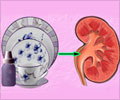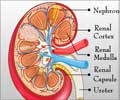Repeated procedures, such as balloon angioplasty are often needed by kidney dialysis patients in order to open blood vessels that become blocked
Repeated procedures, such as balloon angioplasty are often needed by kidney dialysis patients in order to open blood vessels that become blocked or narrowed at the point where dialysis machines connect to the body.
These blockages can impact the effectiveness of hemodialysis, a life-saving treatment to remove toxins from the blood when the kidneys are unable to do so. But a new FDA-approved stent graft can keep these access points open longer, reducing the number of procedures these patients may need, according to research from the University of Maryland published in the February 11, 2010, edition of the New England Journal of Medicine."This is the first large-scale randomized study to find a therapy to be superior to the gold standard of balloon angioplasty. We found that using this new stent for dialysis patients whose access grafts have become narrowed improves graft function. It also clearly reduces the need for repeated invasive procedures and interruption of dialysis," explains lead author Ziv Haskal, M.D., chief of vascular and interventional radiology at the University of Maryland Medical Center. Dr. Haskal is also professor of diagnostic radiology and nuclear medicine, and surgery at the University of Maryland School of Medicine.
The prospective multi-center study took place at 13 sites across the country and enrolled nearly 200 patients. Ninety-seven patients received angioplasty with the new stent, which is a small metal scaffold inserted in the patient's arm, compared to 93 who received angioplasty alone.
In the study, patients with the stent graft were more than twice as likely to have open vessels compared to the angioplasty only group after six months. The recurrence of vessel narrowing, restenosis, was nearly three times lower with the stent group, (27.6 percent vs. 77.6 percent). In later follow-up, some patients still had functioning grafts two years after the stent graft was first implanted.
"Results of this research should change the way we treat hemodialysis patients. In this study, patients who received angioplasty alone were twice as likely to need additional procedures compared to those who had the stent in addition to angioplasty," adds Dr. Haskal. "That can translate into cost savings and improved quality of life for these patients, who already spend about nine to 12 hours a week in dialysis. We can now start considering grafts as something that may last for years in dialysis patients, instead of months."
According to the researchers, the cost to treat dialysis access failure amounts to about $1 billion per year, and the number of patients needing hemodialysis is expected to continue to grow substantially over the next decade.
Advertisement
For hemodialysis, scar tissue naturally forms at the edges of the access grafts. That scarring can impede blood flow, requiring doctors to perform angioplasty to open the vessels. In that outpatient procedure, doctors insert a balloon into the blood vessel and inflate the balloon to open the narrowed artery or vein. Following angioplasty, vessel narrowing frequently recurs, requiring repeated procedures, up to several times a year. If scarring becomes too severe and repeated angioplasties do not work, the patient may need another procedure put in an access graft at a different site on the arm. Other therapies have been compared to balloon angioplasty, but, until now, none has shown benefit in a prospective randomized study.
Advertisement
"This study offers strong evidence of the benefit of using this new stent therapy for hemodialysis patients. It represents the type of important clinical research with direct patient benefit undertaken by physicians at the University of Maryland School of Medicine," says E. Albert Reece, M.D., Ph.D., M.B.A, vice president for medical affairs, University of Maryland, and dean, University of Maryland School of Medicine.
Source-Eurekalert
RAS










